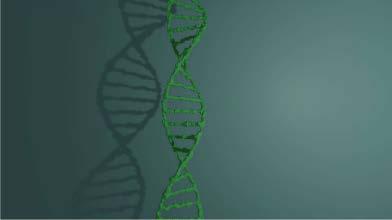DNA

DNA, or deoxyribonucleic acid, is the hereditary material in humans and almost all other organisms. Nearly every cell in a person’s body has the same DNA. Most DNA is located in the cell nucleus (where it is called nuclear DNA), but a small amount of DNA can also be found in the mitochondria (where it is called mitochondrial DNA or DNA). Mitochondria are structures within cells that convert the energy from food into a form that cells can use.
DNA, or deoxyribonucleic acid, is the hereditary material in humans and almost all other organisms. Nearly every cell in a person’s body has the same DNA. Most DNA is located in the cell nucleus (where it is called nuclear DNA), but a small amount of DNA can also be found in the mitochondria (where it is called mitochondrial DNA or DNA). Mitochondria are structures within cells that convert the energy from food into a form that cells can use.
The information in DNA is stored as a code made up of four chemical bases: adenine (A), guanine (G), cytosine (C), and thymine (T). Human DNA consists of about 3 billion bases, and more than 99 percent of those bases are the same in all people. The order, or sequence, of these bases, determines the information available for building and maintaining an organism, similar to the way in which letters of the alphabet appear in a certain order to form words and sentences.
An important property of DNA is that it can replicate or make copies of itself. Each strand of DNA in the double helix can serve as a pattern for duplicating the sequence of bases. This is critical when cells divide because each new cell needs to have an exact copy of the DNA present in the old cell.

Facts about DNA
The discovery of the structure of DNA would not have been possible without the work of Rosalind Franklin. James Watson and Francis Crick built much of their research on the discovery of the DNA double helix on Franklin’s experimental data. Her pioneering use of X-ray diffraction on DNA fibres was key to understanding the structure of DNA.
Each person has approximately 20,000-25,000 genes. The majority of the human genome is made up of noncoding DNA called “junk DNA.” However, recent studies have shown that noncoding DNA may play a more important role than previously realized.
It is possible for a person to have two totally different sets of DNA, which are known as chimaeras. A chimaera can occur when a person absorbs their own twin in the womb or if the person undergoes a bone marrow transplant.
Use of DNA
DNA is necessary for the inception of life. The main tasks carried out by this acid involve the transfer of hereditary information from one generation to the next and controlling the production of proteins. DNA also plays an important part in determining the structure and functionality of cells. It is known to store information coded in the form of biological molecules. The amount of data in DNA is very large. A simple E. coli bacteria have DNA with nucleotides, which are about 4 million in number. One can, therefore, get an idea about how much information is present in the DNAs of different organisms present in this world. Unveiling the information that lies in its sequences proves to be helpful for scientists.
References
https://www.nature.com/articles/nature01406
https://www.geni.com/blog/15-interesting-facts-about-dna-3100762.html
https://theconversation.com/us/topics/dna-251
https://medlineplus.gov/genetics/understanding/basics/dna/
https://pubmed.ncbi.nlm.nih.gov/25903461/
https://www.thoughtco.com/interesting-dna-facts-608188
https://www.factretriever.com/dna-facts
https://dnacenter.com/blog/10-fun-facts-dna/
https://www.yourgenome.org/facts/what-is-dna
Pic: 3d structure of DNA made by Ahmed Shaaif Shareef using Blender.
Author biography
Ahmed Shaaif Shareef likes exploring new things and love spending time with my family and loved ones. His favourite sport is Football. In his spare time, Shaaif likes to reading books, mostly stories and play video games. He has also learnt coding skills through the Coding and Critical Thinking programmer of theCircle by Ugail Foundation. He also takes part in leadership roles in school activities and is currently elected to the school prefect board. He is currently enrolled in the Leaders of Tomorrow programme by the Ugail Foundation - he believes that this is an opportunity for him to learn more about leadership roles and build his career after his studies.

Cite this article as:
Ahmed Shaaif Shareef, DNA, theCircle Composition, Volume 2, (2022). https://thecirclecomposition.org/dna/
